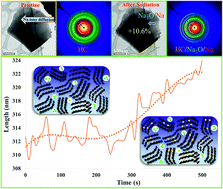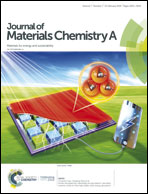Sodium storage in hard carbon with curved graphene platelets as the basic structural units†
Abstract
Hard carbon is demonstrated as an anode material of high capacity and cycling stability in sodium ion batteries (SIBs). However, the structure uncertainty of hard carbon and lack of understanding about its sodium-storage mechanism have limited its further optimization. Here, we have studied the atomic structures of pristine and sodiated hard carbon by in situ and ex situ transmission electron microscopy and correlated the microstructures with their electrochemical properties. Unlike graphite with its almost flat graphene layers, the graphene layers in hard carbon are normally curved. Such curved graphene layers form a platelet as the basic structural unit and the platelets pack randomly to form a 3D porous structure. As the graphene layers are curved and misaligned, their interlayer distance is large and suitable for Na-ions intercalation. During in situ sodiation, an obvious volume expansion that resulted from Na intercalation is observed near the end of sodiation, implying that intercalation of Na into the curved graphene platelets (corresponding to the voltage plateau ∼0.15 V) occurs after Na absorption in the surface/defect absorption (corresponding to a voltage slope from ∼2 to 0.15 V). Our investigation will provide insights for designing and fabricating more effective hard carbon for next generation SIBs with high capacity and cyclability.

- This article is part of the themed collection: 2019 Journal of Materials Chemistry A Most Popular Articles


 Please wait while we load your content...
Please wait while we load your content...